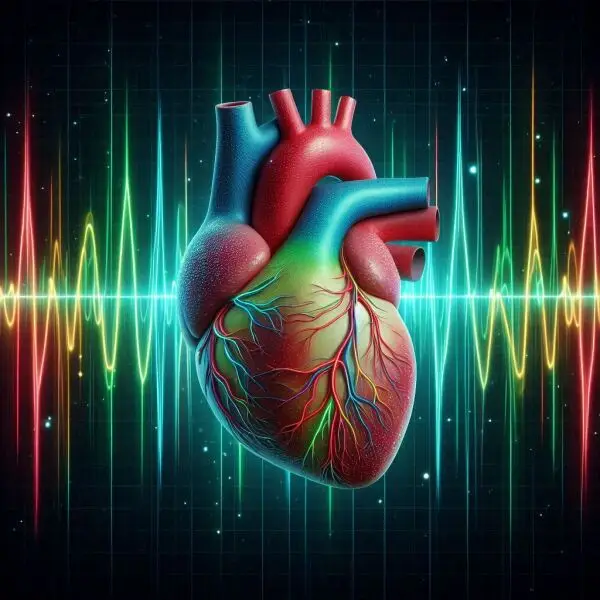Atrial Fibrillation: Detect It in Time and Reduce the Risk of Stroke
Discover how to timely detect atrial fibrillation, a dangerous arrhythmia. Learn about the innovative technology to monitor your heart from home....
Table of Contents
- Atrial Fibrillation: A Silent Risk
- Importance of Regular Monitoring
- Innovative Technology for Heart Monitoring
- Prevention and Care from Home
Follow Patricia Alegsa on Pinterest!
Atrial Fibrillation: A Silent Risk
Atrial fibrillation, although often silent, is one of the most dangerous arrhythmias that can affect the heart. This disorder causes rapid and irregular heartbeats, which can exceed 400 per minute.
The symptoms can easily be confused with simple palpitations, dizziness, or mild fatigue, making detection difficult. However, this condition hides a significant risk: around 15% to 20% of people who suffer a stroke (CVA) have atrial fibrillation.
As the population ages, the risk of developing this arrhythmia increases. Atrial fibrillation can cause blood to pool in the upper chambers of the heart, increasing the likelihood of clot formation that, if they reach the brain, can cause a stroke. Therefore, early detection and regular monitoring are crucial to prevent serious complications.
Systolic pressure increases the risk of stroke
Periodic blood pressure checks and electrocardiograms are essential for timely detection of atrial fibrillation. Awareness of this arrhythmia and continuous monitoring not only helps prevent serious complications but also optimizes treatment and avoids unnecessary visits to the emergency room.
As the population ages, the risk of developing this arrhythmia increases. Atrial fibrillation can cause blood to pool in the upper chambers of the heart, increasing the likelihood of clot formation that, if they reach the brain, can cause a stroke. Therefore, early detection and regular monitoring are crucial to prevent serious complications.
Systolic pressure increases the risk of stroke
Importance of Regular Monitoring
Periodic blood pressure checks and electrocardiograms are essential for timely detection of atrial fibrillation. Awareness of this arrhythmia and continuous monitoring not only helps prevent serious complications but also optimizes treatment and avoids unnecessary visits to the emergency room.
Although symptoms can be subtle, it is crucial to pay attention to any irregularities in heartbeats.
Recent studies have shown that atrial fibrillation does not only affect older adults but is also on the rise among young people. Factors such as hypertension, diabetes, and the consumption of alcohol and tobacco are determinants in the development of this condition.
Recent studies have shown that atrial fibrillation does not only affect older adults but is also on the rise among young people. Factors such as hypertension, diabetes, and the consumption of alcohol and tobacco are determinants in the development of this condition.
The relationship between hypertension and atrial fibrillation is concerning, as between 60% and 80% of patients with this arrhythmia also suffer from hypertension.
The blood tests that help care for your heart
Technological innovation has enabled the development of devices that facilitate heart monitoring from home. For example, the OMRON Complete, developed in collaboration with Kyoto University, integrates blood pressure measurement and electrocardiograms (ECG) into a single device.
The blood tests that help care for your heart
Innovative Technology for Heart Monitoring
Technological innovation has enabled the development of devices that facilitate heart monitoring from home. For example, the OMRON Complete, developed in collaboration with Kyoto University, integrates blood pressure measurement and electrocardiograms (ECG) into a single device.
This equipment allows users to quickly and effectively identify cardiac irregularities, facilitating medical intervention and optimizing treatments.
The use of these devices is simple; users only need to place their fingers on the sensors to obtain an instant reading, without the need for traditional electrodes. Moreover, the system classifies heart rhythms and stores readings along with blood pressure measurements for comprehensive monitoring. This not only improves the quality of medical care but also reduces the need for frequent consultations.
Why it is necessary for a doctor to monitor your heart
Continuous monitoring of heart health is essential to prevent serious complications, such as strokes. The ability to perform electrocardiograms at home allows for early detection of arrhythmias and helps patients take an active role in their heart health.
The use of these devices is simple; users only need to place their fingers on the sensors to obtain an instant reading, without the need for traditional electrodes. Moreover, the system classifies heart rhythms and stores readings along with blood pressure measurements for comprehensive monitoring. This not only improves the quality of medical care but also reduces the need for frequent consultations.
Why it is necessary for a doctor to monitor your heart
Prevention and Care from Home
Continuous monitoring of heart health is essential to prevent serious complications, such as strokes. The ability to perform electrocardiograms at home allows for early detection of arrhythmias and helps patients take an active role in their heart health.
With the increasing use of wearable devices designed to detect atrial fibrillation, it is expected that the prevalence of this condition in healthcare settings will decrease, thanks to more effective management of cardiovascular health.
Atrial fibrillation is a condition that, although silent, can have devastating consequences. However, early detection, regular monitoring, and the use of innovative technologies can make a difference in the quality of life for those affected. It is essential that individuals pay attention to their heart health and seek medical attention for any unusual symptoms.
Atrial fibrillation is a condition that, although silent, can have devastating consequences. However, early detection, regular monitoring, and the use of innovative technologies can make a difference in the quality of life for those affected. It is essential that individuals pay attention to their heart health and seek medical attention for any unusual symptoms.
Subscribe to the free weekly horoscope
Aquarius Aries Cancer Capricorn Gemini Leo Libra Pisces Sagittarius Scorpio Taurus Virgo
I am Patricia Alegsa
I have been writing horoscope and self-help articles professionally for over 20 years.
Subscribe to the free weekly horoscope
Receive weekly in your email the horoscope and our new articles on love, family, work, dreams and more news. We do NOT send spam.
Astral and numerological analysis
-
 Discover your future, secret personality traits and how to improve in love, business and life in general
Discover your future, secret personality traits and how to improve in love, business and life in general
-
 Online Dream Interpreter: with artificial intelligence
Do you want to know what a dream you had means? Discover the power of understanding your dreams with our advanced online dream interpreter using artificial intelligence that responds to you in seconds.
Online Dream Interpreter: with artificial intelligence
Do you want to know what a dream you had means? Discover the power of understanding your dreams with our advanced online dream interpreter using artificial intelligence that responds to you in seconds.

















